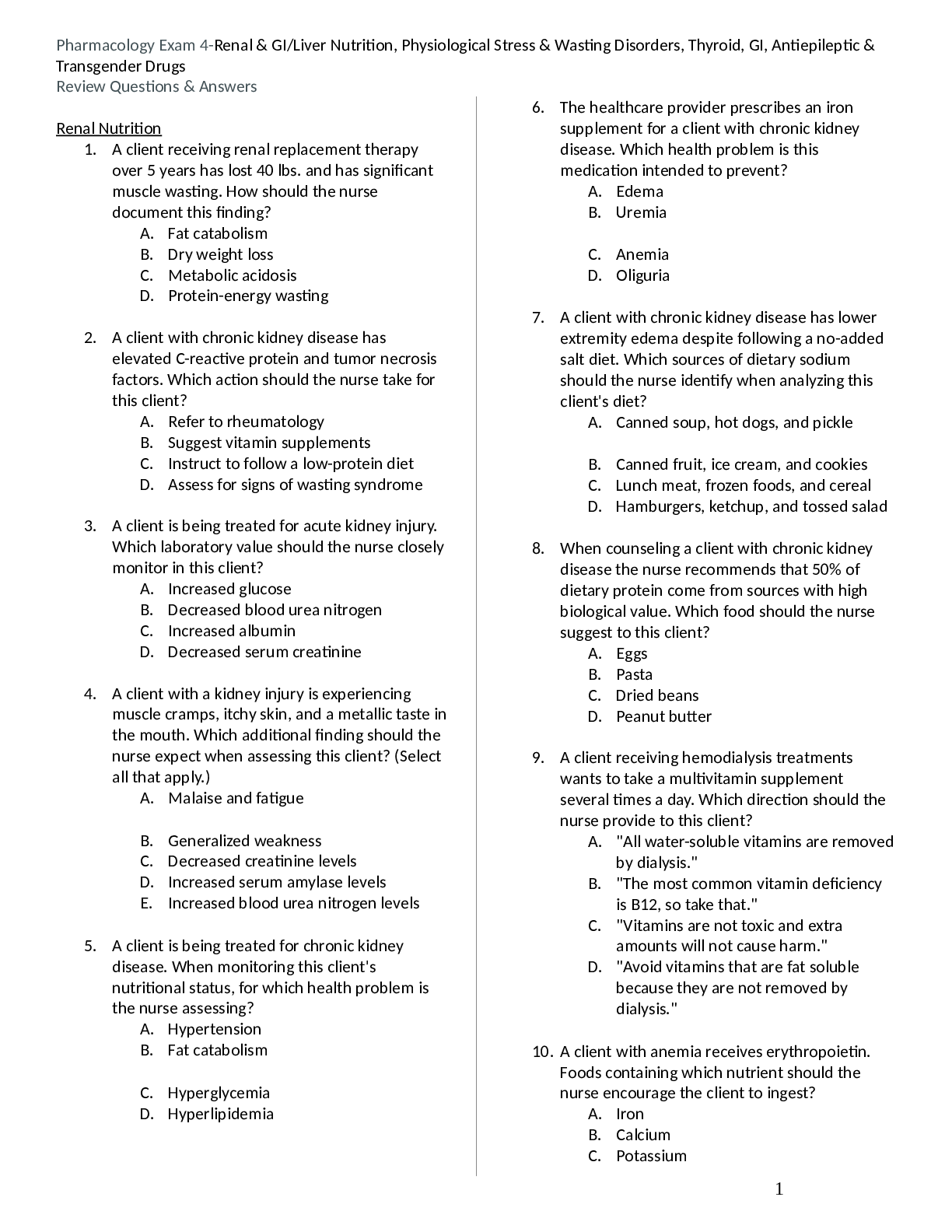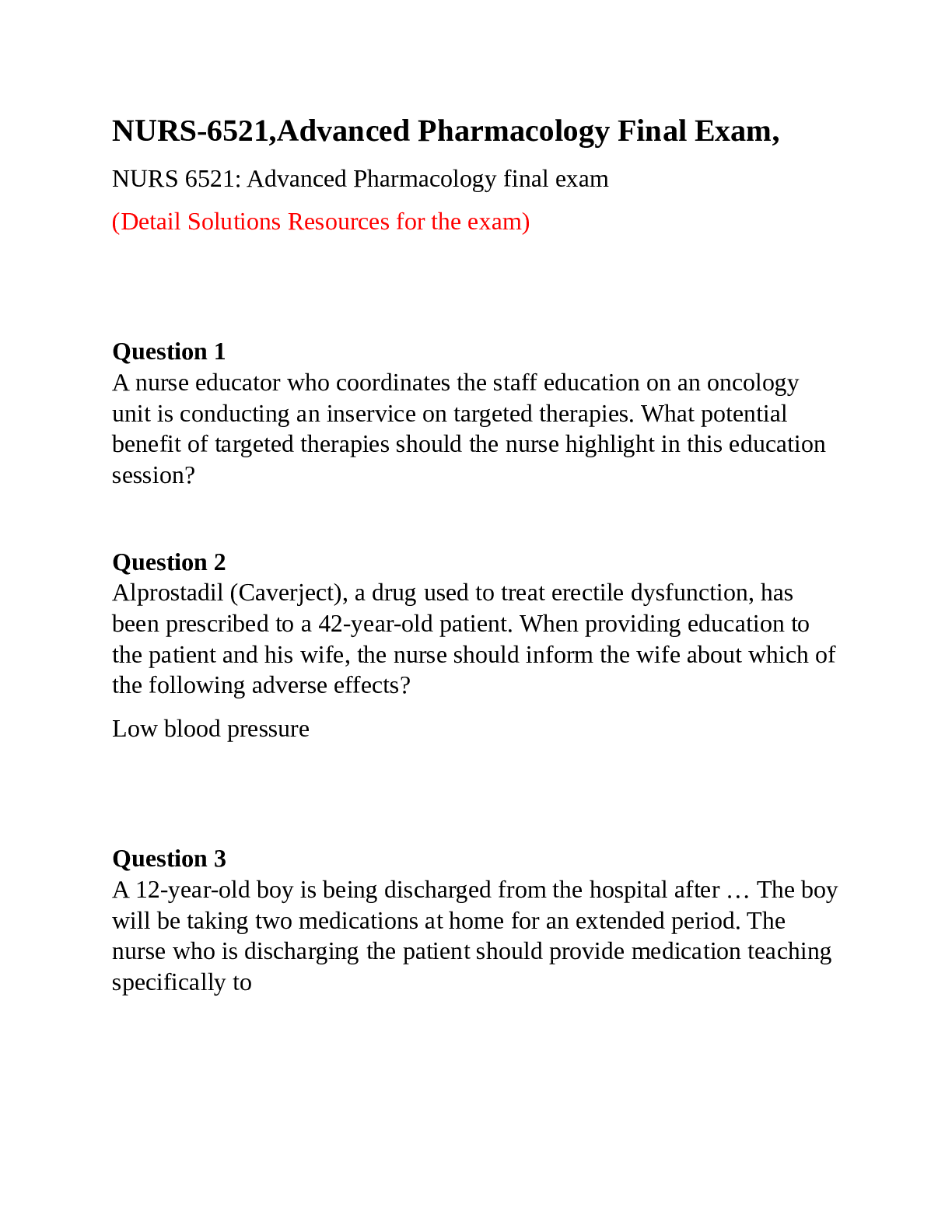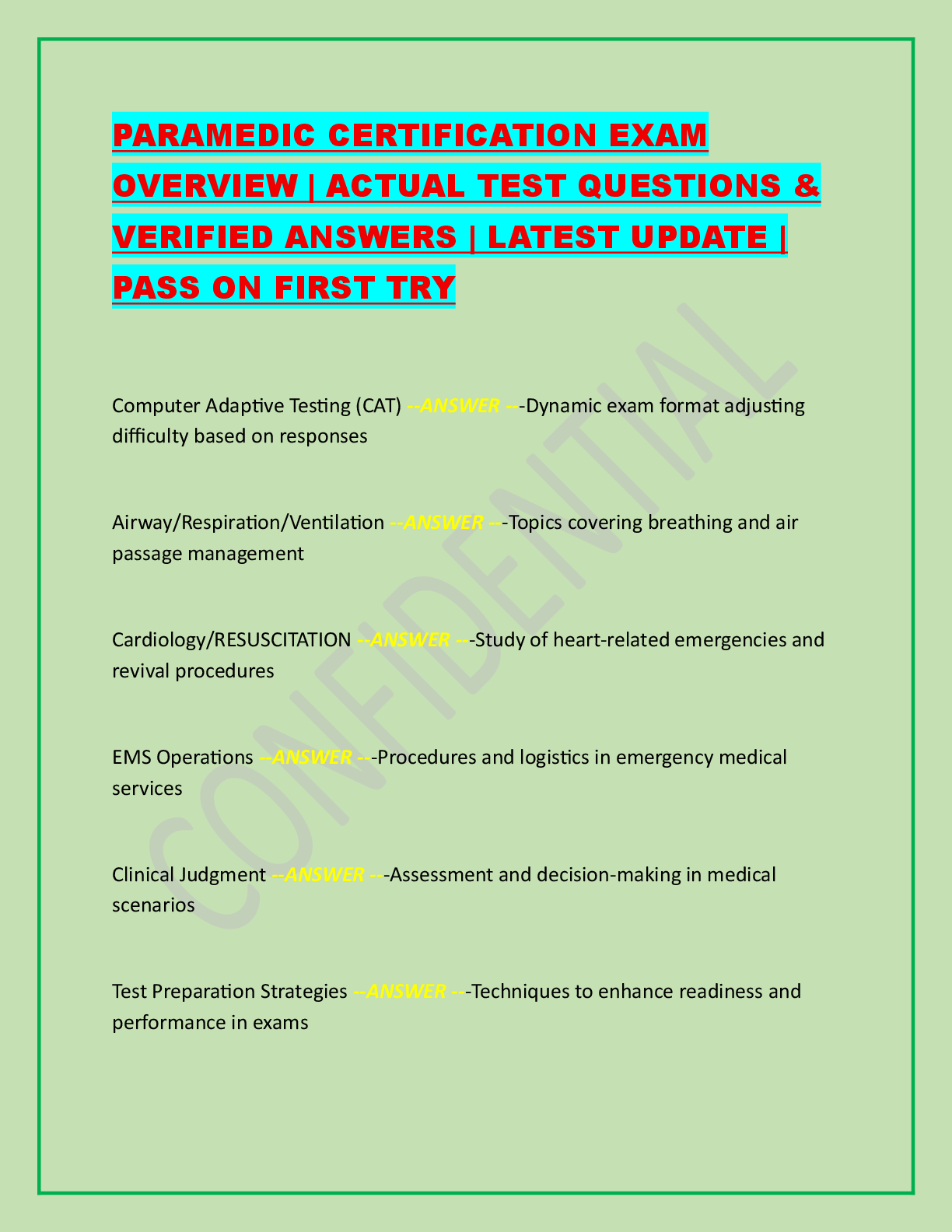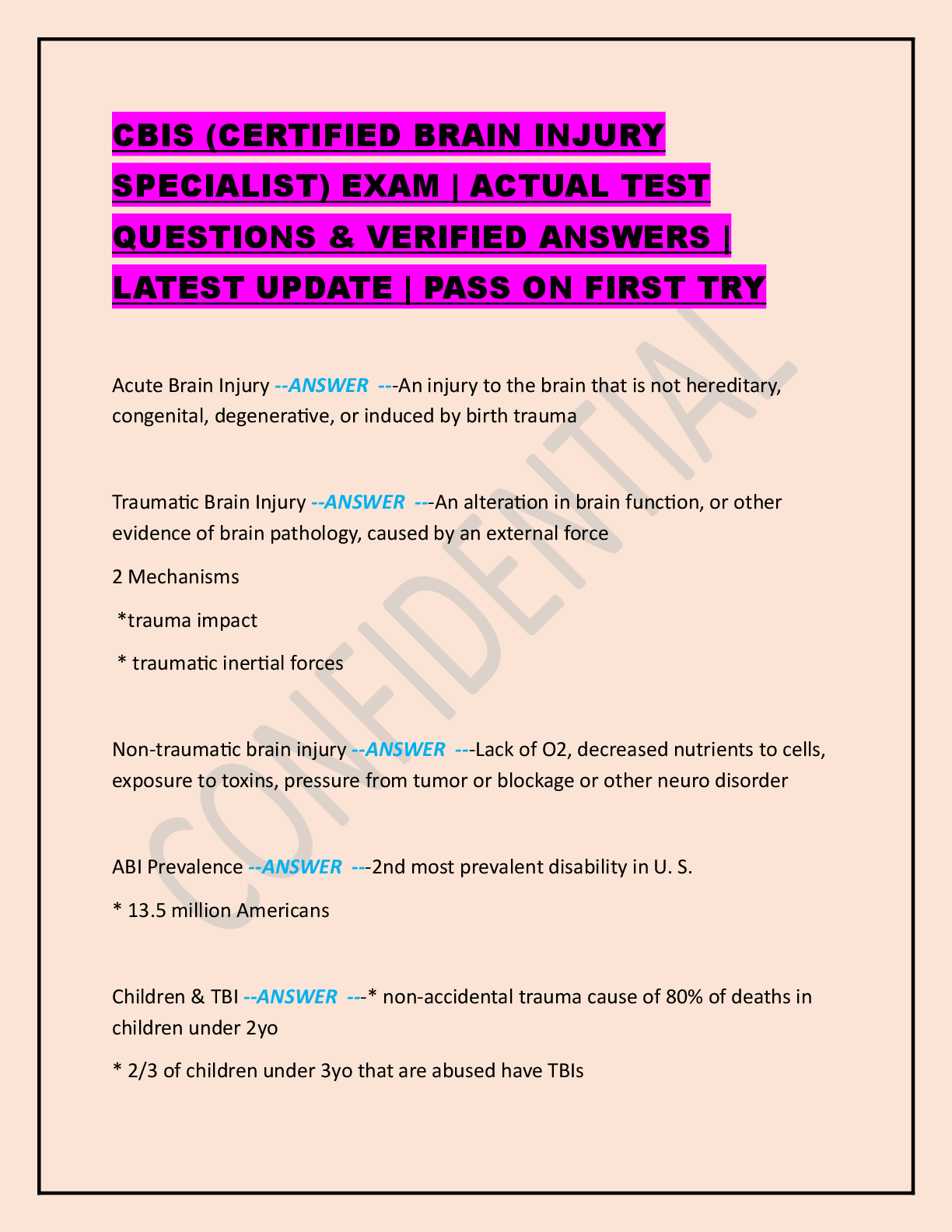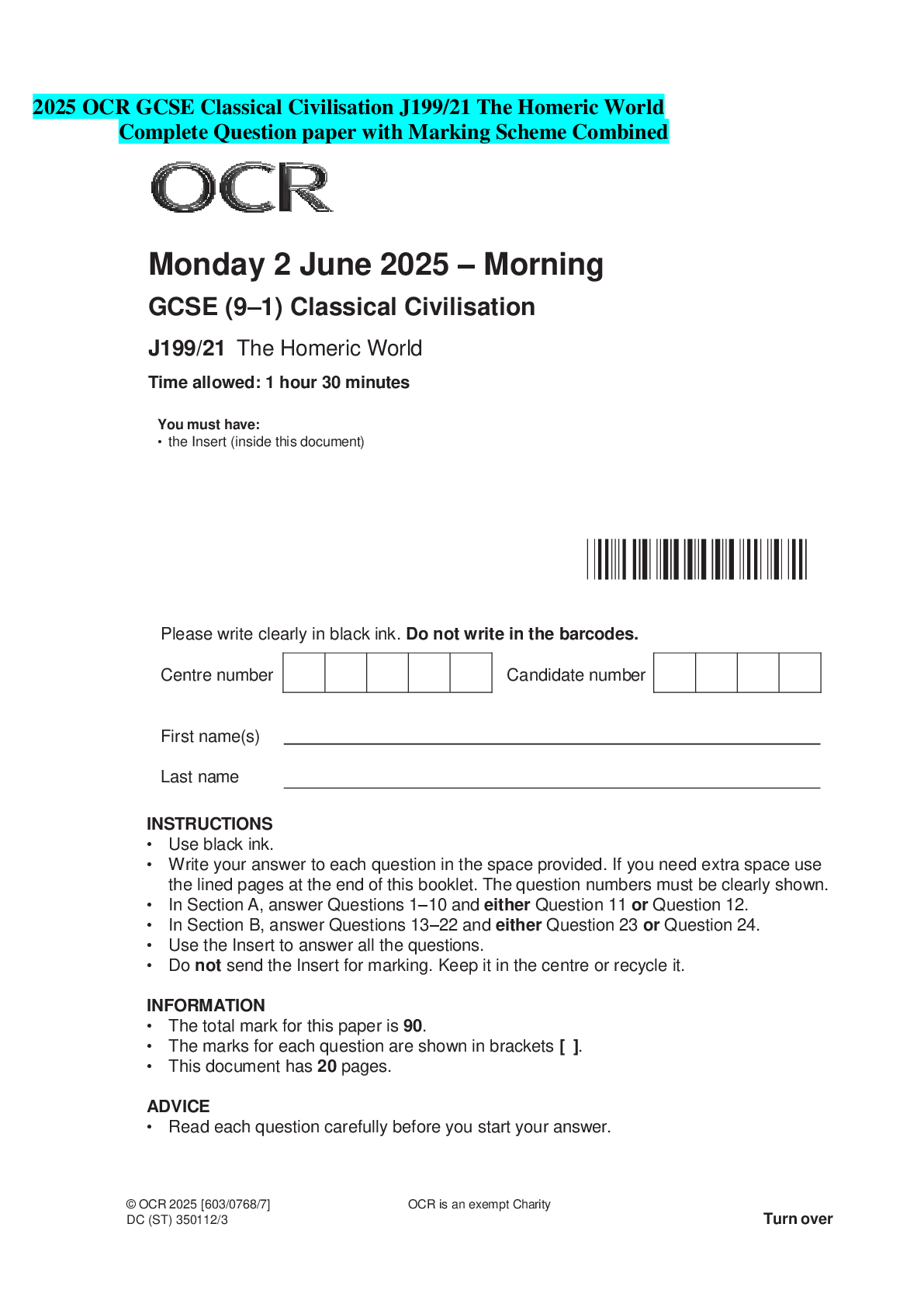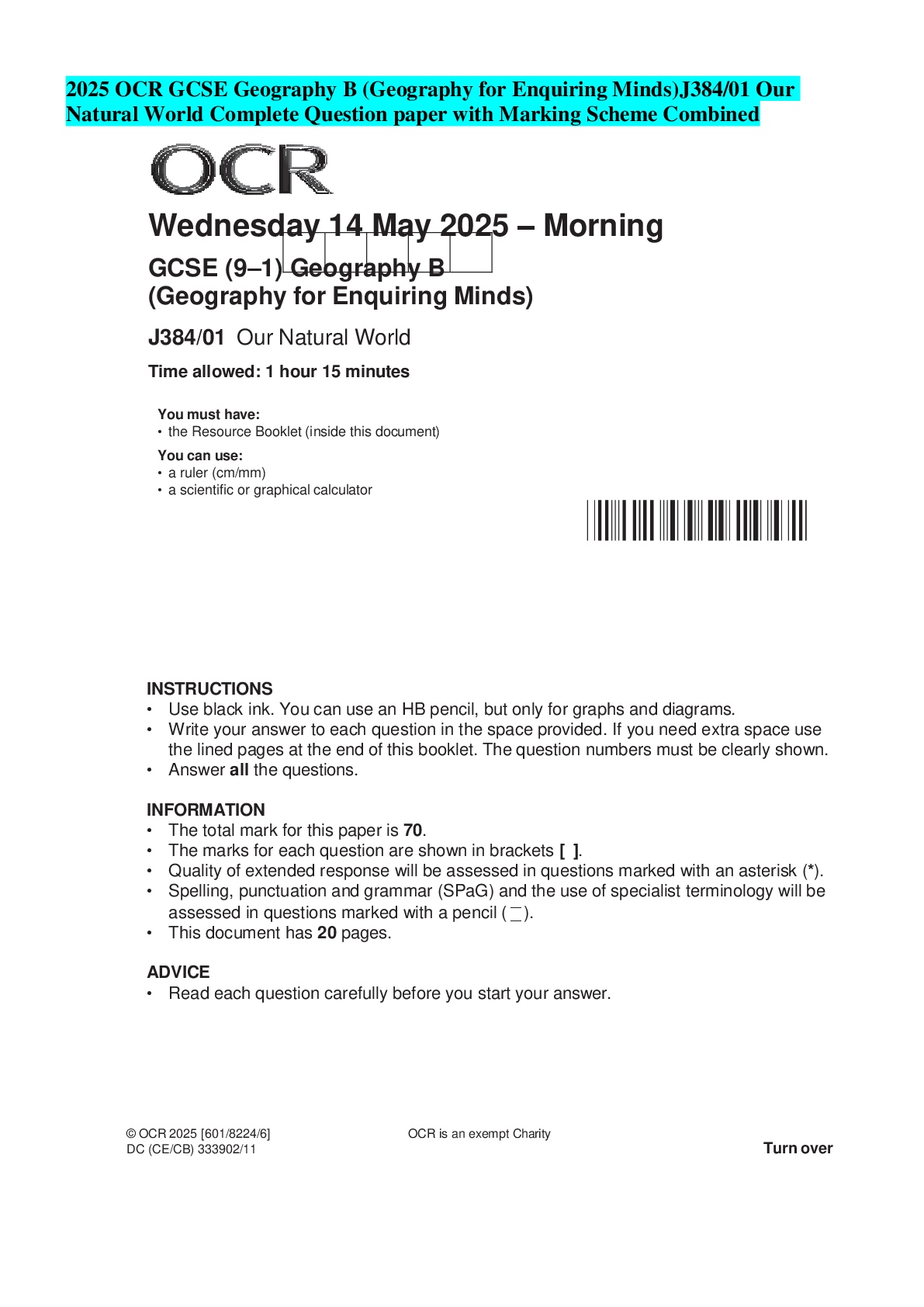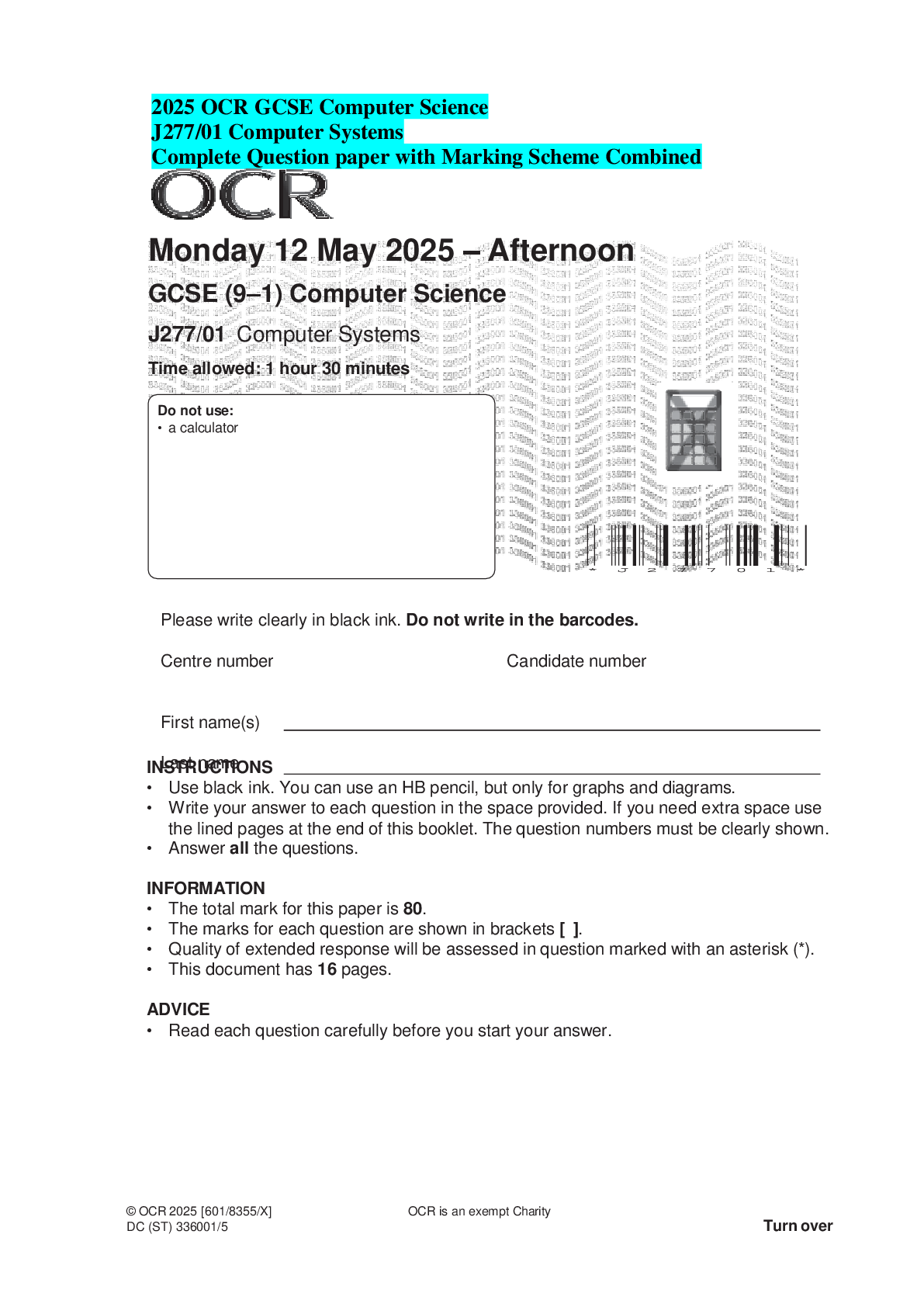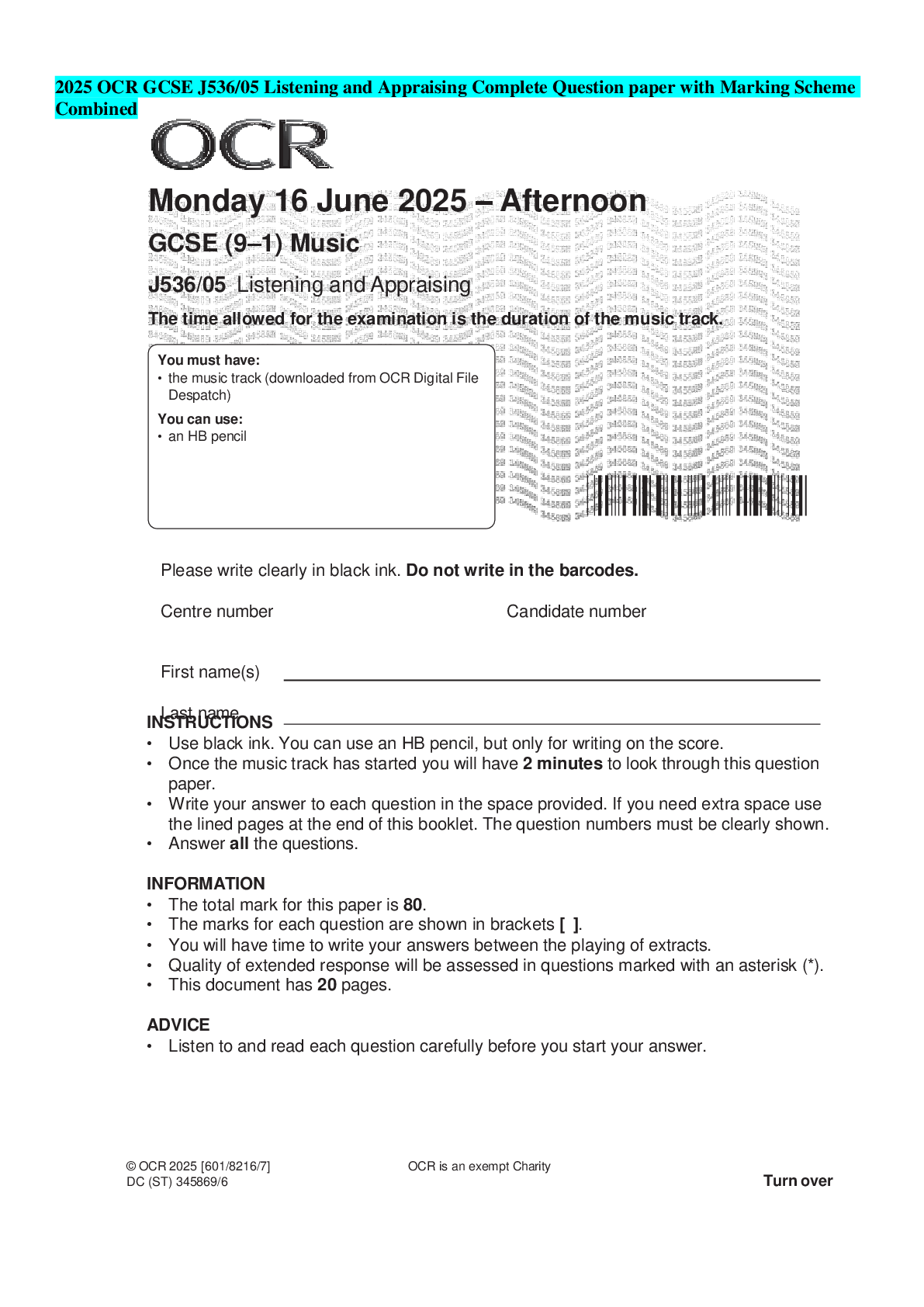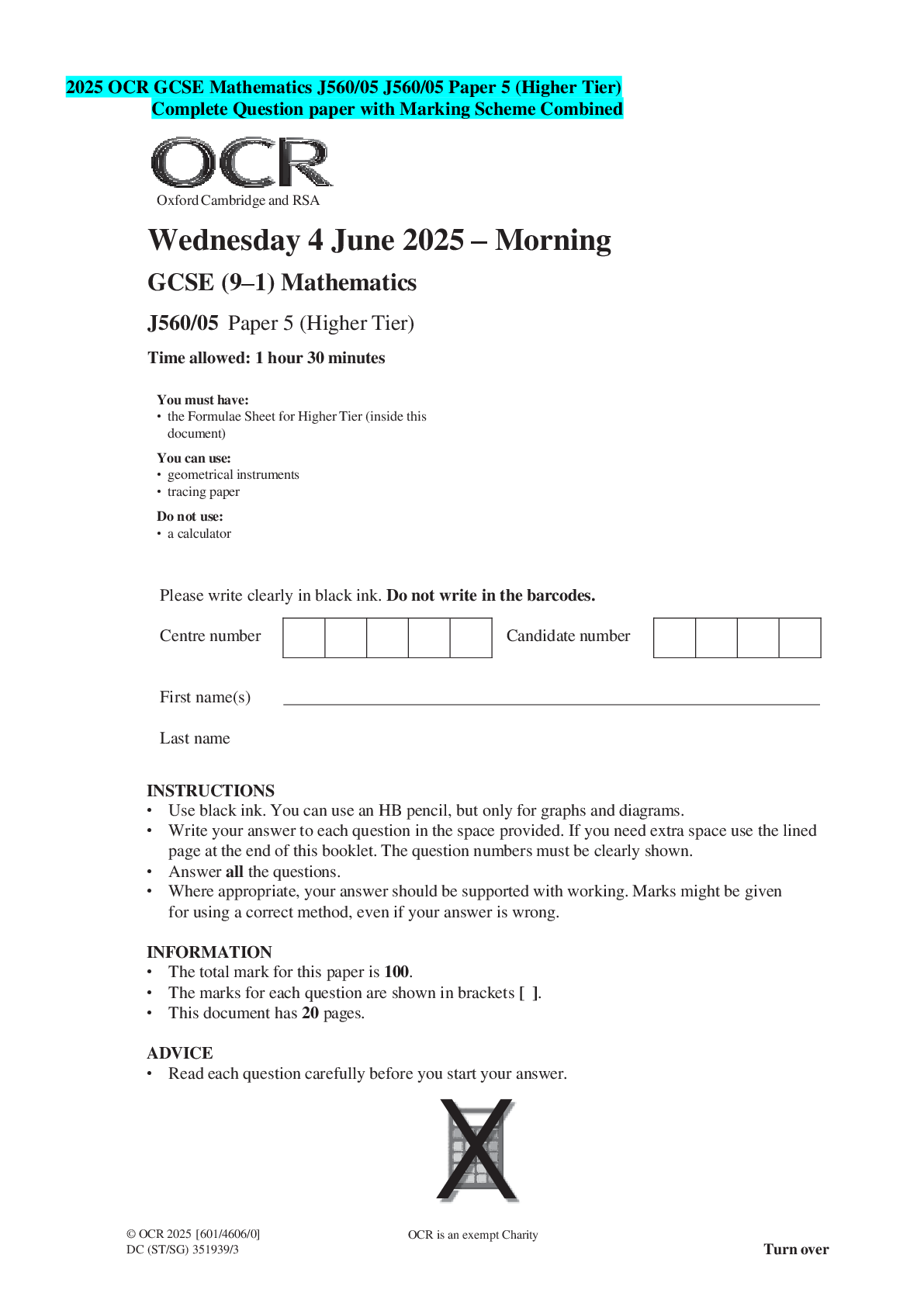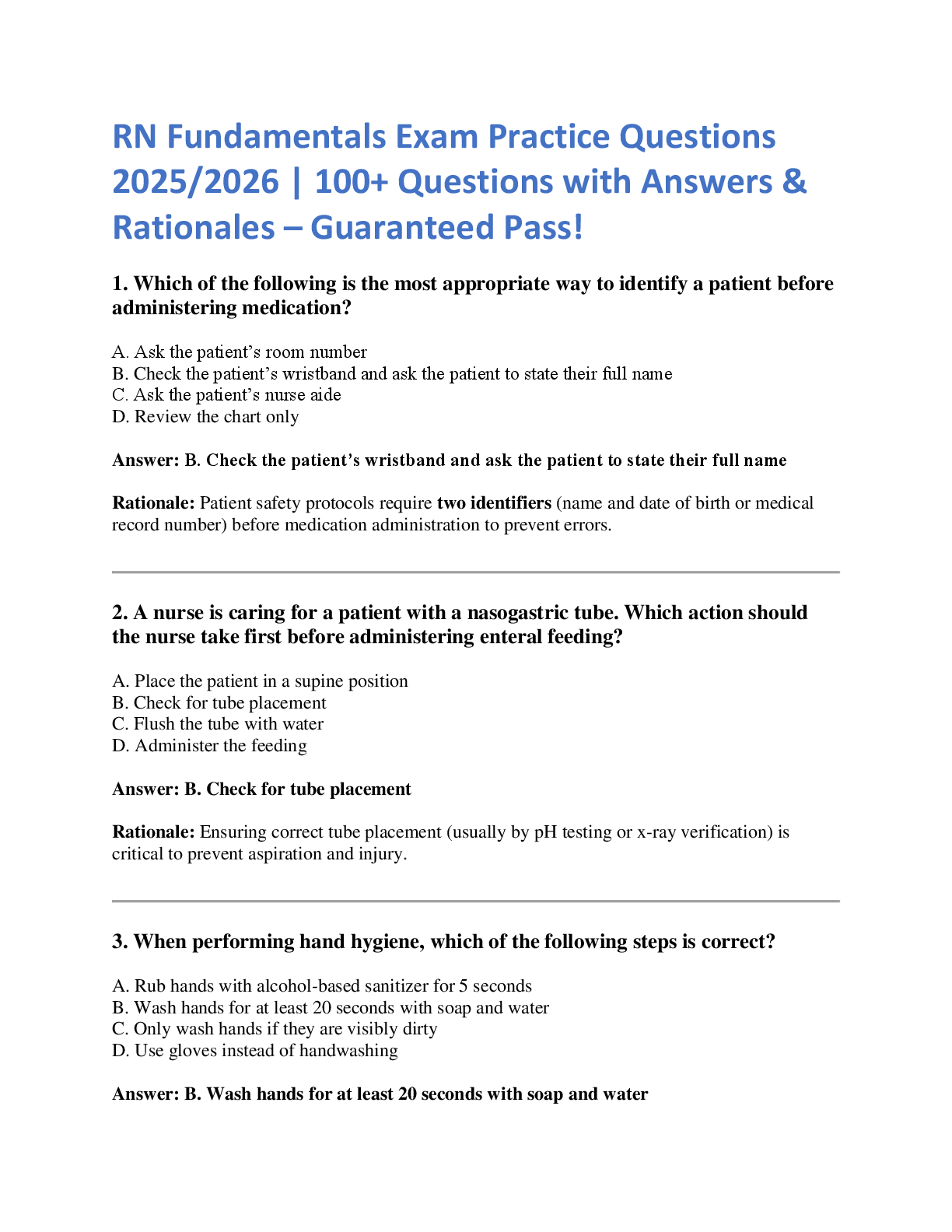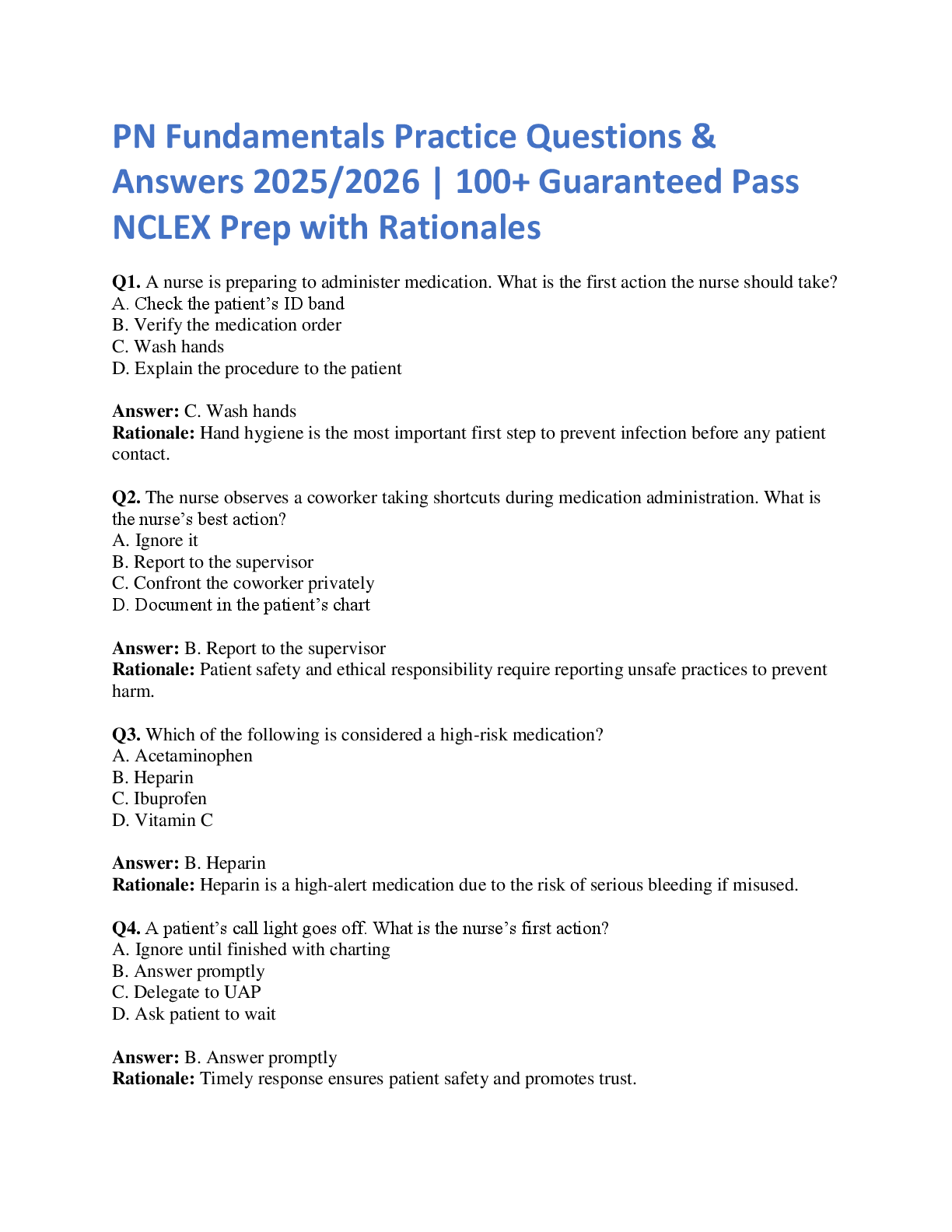*NURSING > EXAM REVIEW > Brownie Recipe Final Exam Review (All)
Brownie Recipe Final Exam Review
Document Content and Description Below
3 1. Consequence of too much O2 → dry & cracking oral mucosa 2. PE s/sx → petechiae, pleural rub, tachycardia (not bradycardia, hypertension) 3. 1 day post surgery (thoracotomy), what should th ... e nurse do? → teach about incentive spirometer and high fowler’s position (not give O2 nasal cannula) 4. CVP increase → possible right ventricular failure 5. Digoxin toxicity s/sx → nauseous with loss of appetite [REPEAT] 6. Apical pulse location → (image) mitral location 7. PaO2 50 mm → severe hypoxia (anything > 60 mm) WEEK 4 1. Hypokalemia → “U” wave formation on EKG 2. Client’s partner will suction, ready to be sent home? → they perform it independently 3. Best indicator for heart damage → troponin I 4. Patient is on coumadin, what is concerning → PT 45 seconds (normal: 11-12.5) 5. Suspected MI, what do you do first → oxygen WEEK 5 1. Type I patient insulin therapy, barriers? → literacy, dexterity, culture, motivation 2. Give Lispro, when do you wanna give insulin → 15 minutes before breakfast 3. Give furosemide, what do you teach → give foods high in potassium 4. What does coumadin do → prevent stroke in patients with atrial fibrillation 5. SIADH → fluid restriction 6. DKA, blood sugar goes down to 240 → change to D5 NS IV fluid 7. Cushing’s SATA → buffalo hump, purple striation, moon face 8. tPA (tissue plasminogen), what is the most concerning → LOC (not oozing blood) WEEK 6 1. Teaching of Hep B → increase appetite (anorexia) 2. Allergic reaction of blood transfusion → generalized urticaria 3. Asthma exacerbation, priority intervention → nebulizer (not high-fowler's position) 4. +4 edema intervention → pressure relieving mattress 5. Warfarin, contraindication → cabbage (green leafy) 6. Severe cirrhosis → nose bleeding & bruising *bleeding priority* 7. Acute pancreatitis teaching → no cheddar cheese 8. Intervention for ascites → high carbs, high calories (NOT 3in above umbilicus) 9. Cirrhosis, further teaching → “I can eat anything I want” 10. Acute pancreatitis, after pain med → keep them NPO 11. TPN at home teaching (SATA) → keep refrigerated, start D10 if feeding is finished, keep infusion rate if behind on feeding (3) 12. Patient is falling asleep as nurse is talking to them → increased ammonia levels 13. Cholecystitis (SATA) → back rub, incisional splinting, identify pain level, change client position (4) WEEK 7 1. Spinal cord injury, what will occur? → flaccid paralysis 2. What contributes to ICP → sodium 110 (hyponatremia) *always think sodium!* 3. Hep A, early indication → anorexia 4. Acute pancreatitis, where is the pain → epigastric radiating to back 5. What should be reported → ICP of 19 6. Left HH, teaching → put tray & items on patient’s right side 7. Cane teaching with AP → move cane first before legs 8. Stroke teaching → put the patient semi fowlers to facilitate swallowing 9. Associated with embolic stroke → chronic a fib 10. L1, what should you do? → give anticoagulants (they are paralyized → not active ROM exercises) 11. TIA where will you monitor, symptoms go away → go to neurotele & monitor 12. Embolic stroke → it travels 13. Most concern to nurse → unresponsive with arousal 14. ICP sata → headache, slurred speech, eye changes, disorientation 15. Trauma, s/sx hypovolemia → increased HR (tachycardia) Quiz 1 1. SATA AP a. Record Urinary Output b. Assist ambulation pt. Who has a cane c. Move pt to stretcher d. NOT irrigate wound e. NOT eye drops 2. Best position for getting IAP a. Supine 3. PCA a. Pain scale b. IV bolus before lock out c. 30 min lock d. Let fam do it 4. Heparin a. PLT 73,000 b. NOT PTT 65 sec c. Hct 45% d. 5. Holistic care SATA a. Legal members b. Non legal partners c. Anyone the patient identifies as support system d. Siblings 6. Ibuprofen a. Take with food 7. Aspirin a. Expect dark stools b. Monitor tinnitus c. 8. Football on a hot day a. Dehydration Na 152 9. increased CVP what would be the level a. 7 10.What reflects L SIDE afterload a. SVR 11.What would you expect in L HF a. JVD b. Abdominal girth c. Weak peripheral pulses d. dependent edema 12.Suction SATA - Only 3 a. Spontaneous cough b. Cyanosis c. Secretions d. Tachypnea e. …... 13.Increase preload, Fluids a. Crackles 14.Family member in ICU a. Tell fam injuries and plan of care 15.5.4 K a. Call MD b. Omit med 14. New nurse is showing doctor that they have knowledge about using arterial line a. Same level as the phenobarbital axis b. Lay patient supine with head flat c. Recalibrate level after pt moves 15. Adverse effect of digoxin a. Nausea and vomiting 16. What situation do you call RRT for a. Right calf pain and SOB 17. First intervention when patient’s low pressure alarm is ringing? a. Assess cardiac dysrhythmias b. Assess hand for pallor 18. Picture of heart a. The solo on are the right side Quiz 2 1. HR increasing (80-110) and irregular HR a. Hyperoxygenation 2. Requires immediate intervention a. 92% No response to verbal stimuli (i think this was the answer, -KL) 3. Apical pulse a. 5th ICS 4. TB a. Private room special ventilation 5. ET a. Hand Gestures b. Various tech 6. Digoxin a. N/ no appetite 7. CVP a. Right ventricular failure 8. PaO2 50 a. Severe hypoxic 9. SATA PE a. Tachypnea b. Priatial rub c. Petechiae 10. Prevent PE quadraplegic, SATA a. Passive ROM b. SVC c. Assess redness 12. Left arterial line a. Left is cooler than right 11. Thrombus a. Homan’s sign b. (dull aching calf pain) 12. Slow bubbling in water seal chamber a. Monitor resp 13. Oxygen toxicity a. Cracks on mucous membranes 14. Chest tube water chamber norm finding a. Fluctuation 15. Hyperventilation & hypoxic a. CO2 30 pO2 50 16. ET Tube Complication uneven chest rise a. Went to R heart 17. Dyspnea, Deviated... a. Tension Pneumothorax 18. PE 1st RN action a. Oxygenate 19. On Mechanical ventilator risk for infection prevention Don't remember answer a. Drain chamber b. Suction c. Clamp? 20. Tracheal shift a. Tension pneumonia 21. Post op bronchoscopy a. Withhold food and fluids until gag reflex 22. 1 day post op a. High fowlers, Use IS, encourage coughing 23. Blood transfusion - febrile, chills, blood in urine a. Hemolytic reaction 24. Quiz 3 1. What should patient report to provider? a. Crepitus b. Tracheal shift to unaffected side c. Bubbling... 2. SATA O2 therapy N/V a. NOT petroleum, and NOT assessing flow rate every other day b. Inspect ears c. Hang no smoking sign in house d. Check positioning regularly 3. rapid irregular pulse, Pulse deficit a. A-Fib 4. Image on ECG, Hyperkalemia a. T wave 5. Cholesterol diet a. Beans 6. Needs further teaching a. I ate two eggs 7. Come to ER, indigestion, calf pain a. ECG 8. P wave a. Atrial depolarization 9. Cardiac enzymes a. Injury to heart muscle 10.Cardiac enzyme question a. Troponin I 11.Hypokalemia a. Prominent u wave 12.Ventricular depolarization, repolarization a. QT interval 13.Pt on coumadin, enoxaprin, etc a. PT of 45 14.Glipizide for DM 2 15.Hx of coronary artery disease a. Increasing LDL 16.First intervention for MI a. Oxygen (ABC) 17.DVT SATA a. HTN b. Immobility c. Increased Ca+ intake d. Oral contraceptives 18.Patient has a-fib, what vitals are most important a. Apical and radial pulse Quiz 4 1. Warfarin for afib a. Prevents stroke in afib 2. First DKA intervention a. 0.9% Sodium chloride w/ IV drip insulin 3. DKA pt, <260 mg/dL now what do you do a. Add glucose to IV fluids 4. Contributors to noncompliance for diabetes regime a. Dexterity b. Literacy c. Culture d. Motivation 5. SATA of cushings a. Striae b. Moon face c. Buffalo hump 6. tPa priority to look out for a. Decreased loc 7. Dehydration clinical manifestation a. tachycardia 8.Expected finding of addisons a. hyperpigmentation 9. Rapid insulin a. Give food 15min after 10. Thyroidectomy w. Tingling of hands a. Check chvosteck sign 11.Levothyroxine overdose a. insomnia 12. DI given vasopressin how do you know its working a. Urine specific gravity 1.015 13.Prevent thyroid storm a. Provide low stimuli environment 14.Why is nitroglycerin given a. To dilate cardiac blood vessels to deliver more oxygen rich blood back to heart 15. SIADH a. Hyponatremia 16.Stopping prednisone taper down pt teaching a. Adrenal insufficiency 17.Mixing NPH first step a. Inject 20 units of air into NPH vial 18.Statement needing clarification by diabetic woman & CAD about diet a. “I will need to increase intake of trans-fats” 19.Digoxin don’t want to eat a. Check vitals 20.Which insulin do you use for DKA a. Humulin R (regular insulin) 21. Lasix pt teaching a. Eating foods with K 22.What to do for hella hypoglycemic pt with 60mg/dL a. glucagon 23. 3,000 IV in 24h started 1,000 at 0800 when would you start the next 1,000 a. 1600 24. DM 2 pt teaching priority a. Evaluate pt understanding of DM 2 25. Quiz 5 1. Cholecystitis SATA a. Everything but ambulation 2. TPN SATA - refigerate when not used a. keep TPN even after goal weight, dextrose 10 3. Asthma exacerbation, PRIORITY a. b2 nebulizer 4. Cirrhosis, what not to give a. ham sandwich 5. Acites diet a. high carbs, low protein 6. Bile duct cholecystitis a. fatty stool 7. Pancreatitis, pain is addressed what next a. keep NPO status 8. Wafarin, contradiction a. cabbage 9. African American a. check hard palate 10.Cardiac cath a. L radial pulse 11.Levothyroxine toxicity [Show More]
Last updated: 3 years ago
Preview 1 out of 49 pages

Buy this document to get the full access instantly
Instant Download Access after purchase
Buy NowInstant download
We Accept:

Reviews( 0 )
$9.50
Can't find what you want? Try our AI powered Search
Document information
Connected school, study & course
About the document
Uploaded On
Jul 03, 2021
Number of pages
49
Written in
All
Additional information
This document has been written for:
Uploaded
Jul 03, 2021
Downloads
0
Views
145


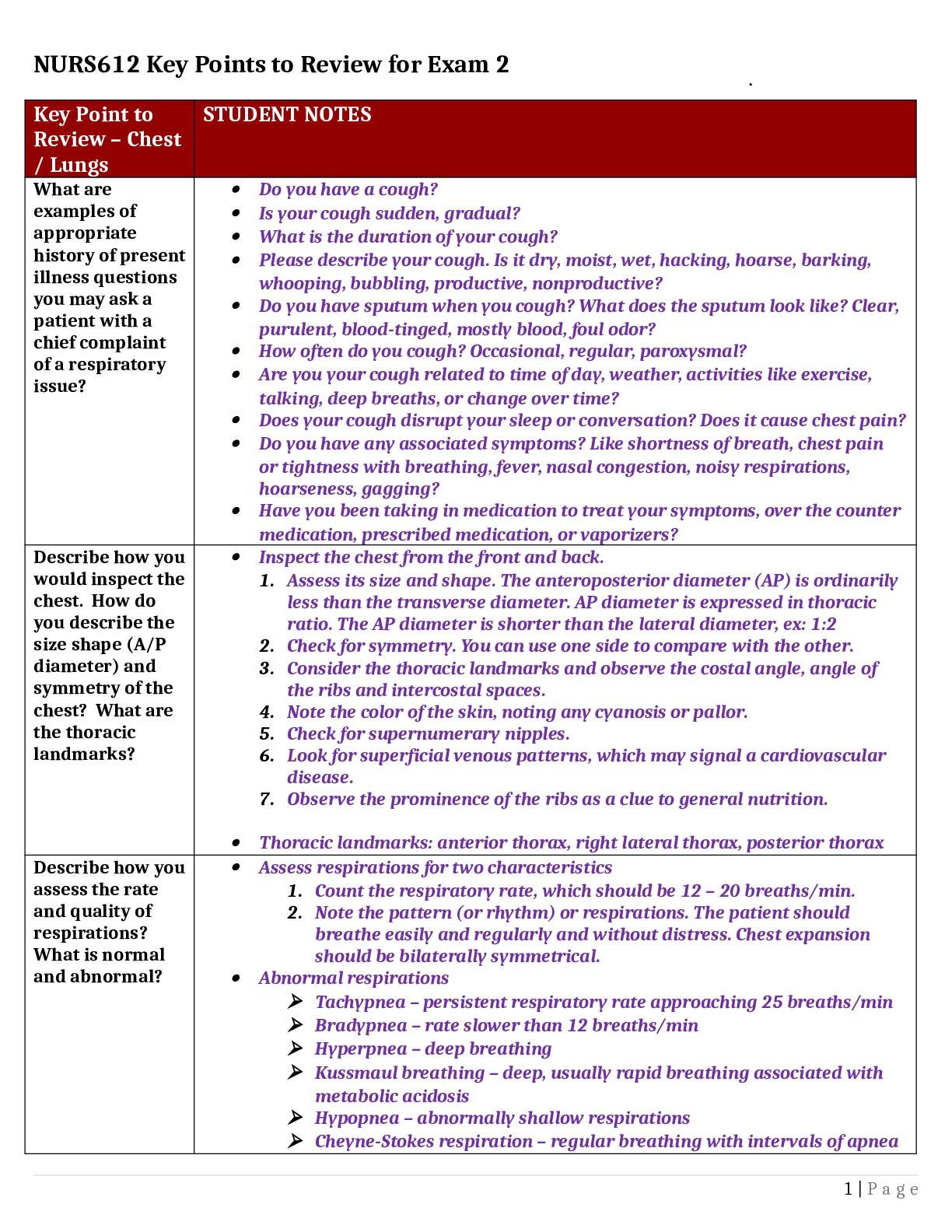
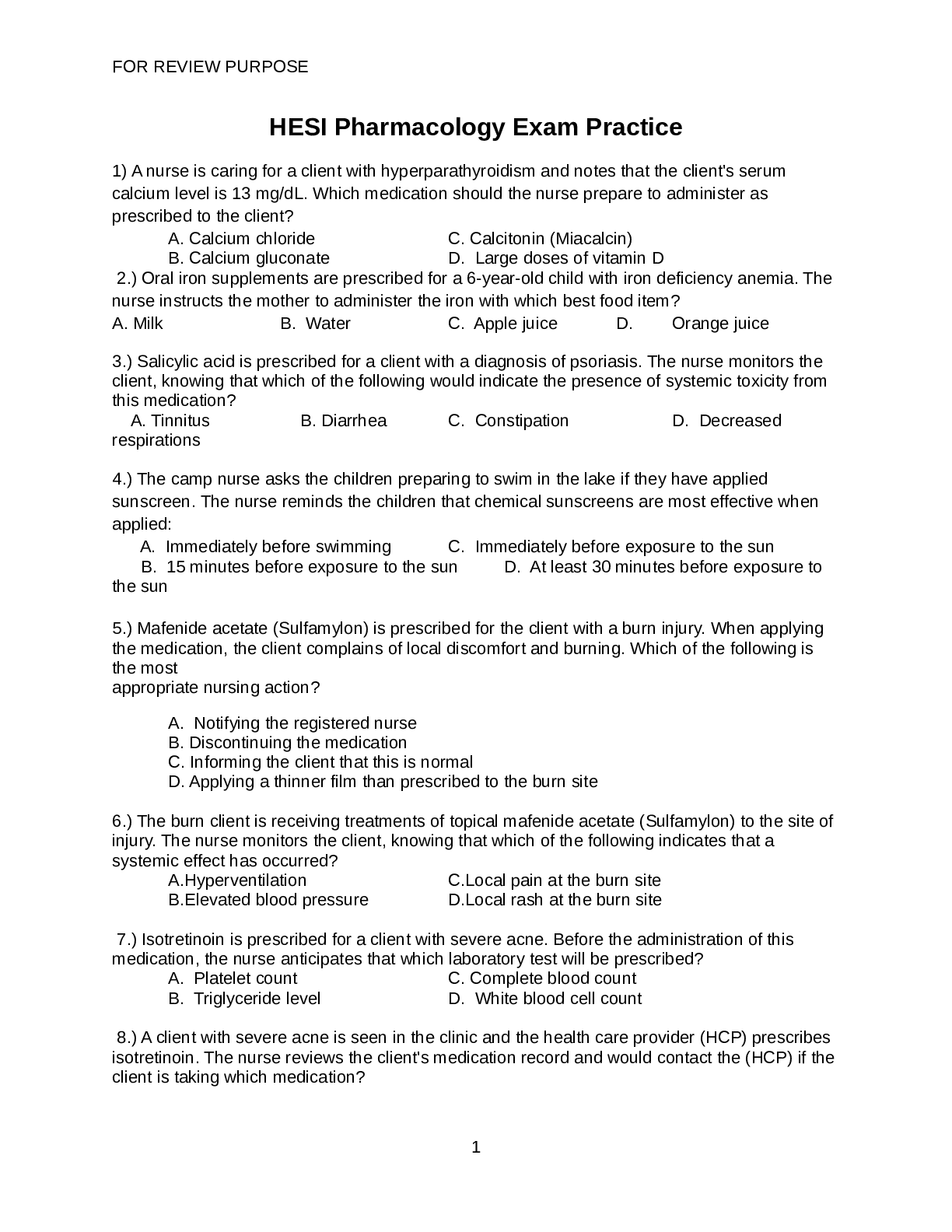
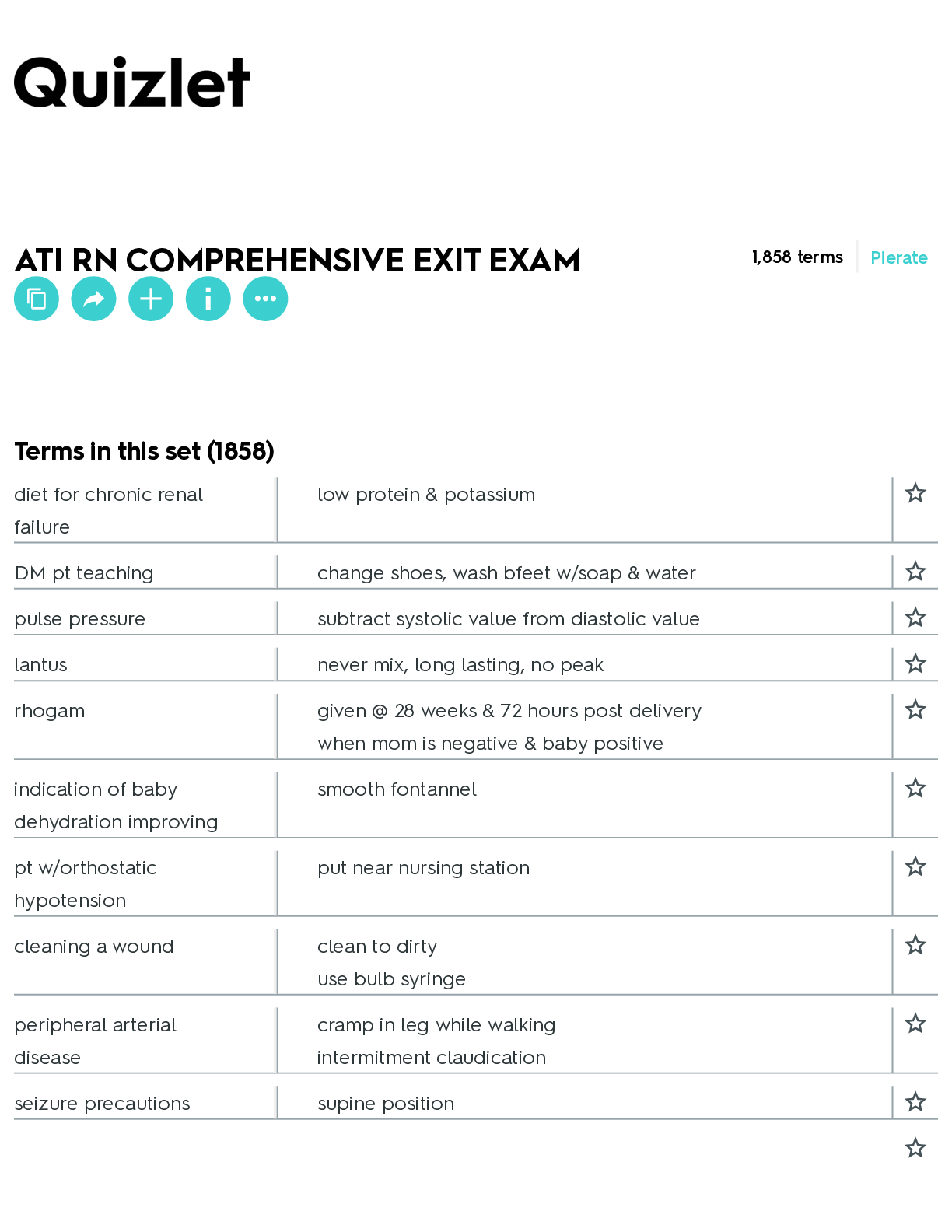
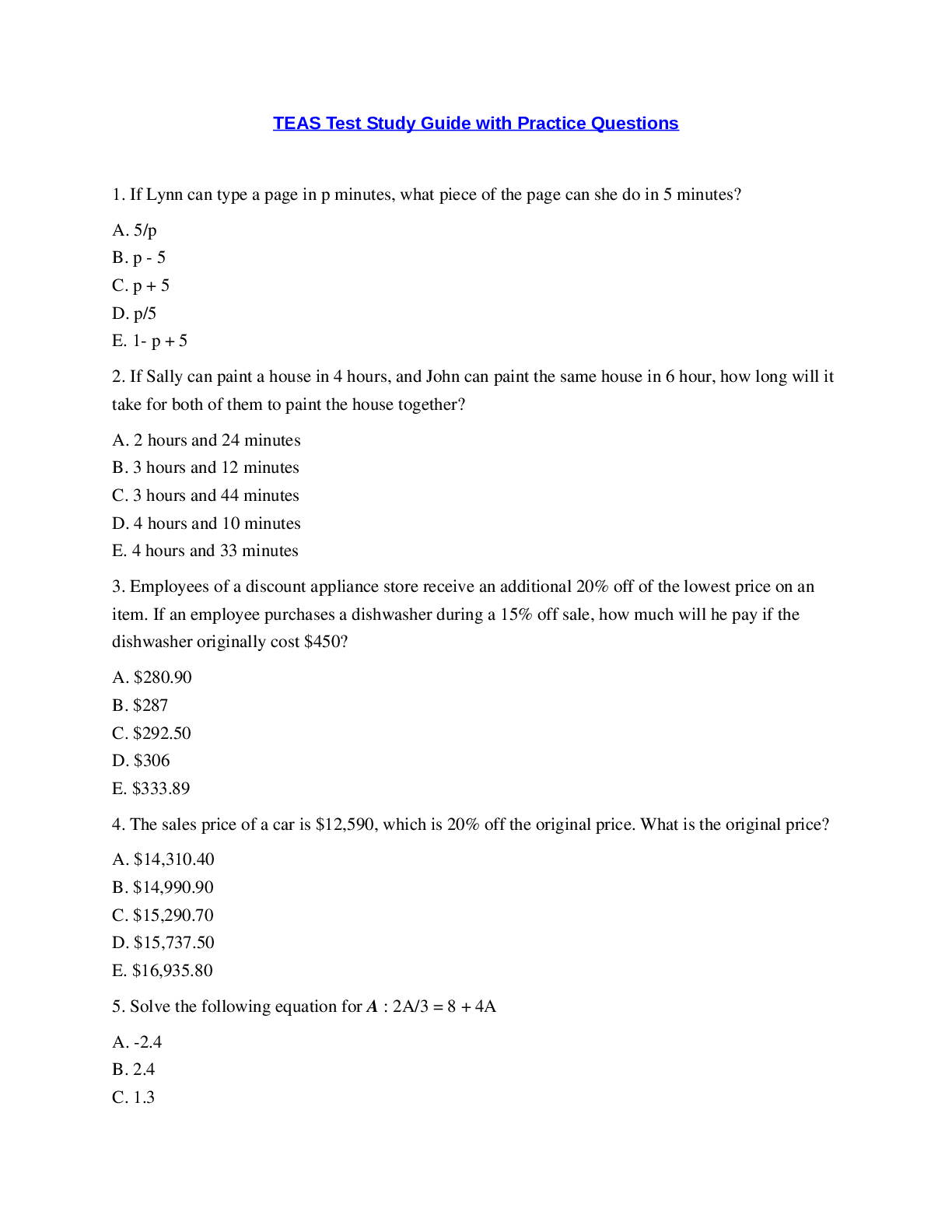
.png)
